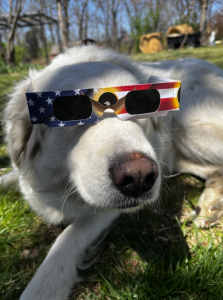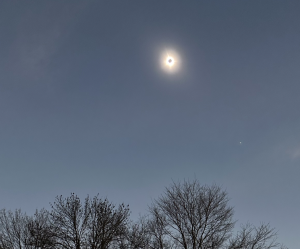Mizzou Academy Science Team and Faculty Marvel at the Great North American Eclipse, April 8, 2024
Posted in: News
“A total solar eclipse is often a once-in-a-lifetime event,” wrote Ericca Thornhill, in our weekly school newsletter the morning of the eclipse. “If your skies are clear, you will be able to see the sun’s corona, where the prominences and flares that make up our sun’s active surface occur. You might also notice night animals chirping, like evening crickets, or some animals acting like it’s bedtime.”
Professor Thornhill, who serves as our Division Chair for Sciences and co-sponsor of the Mizzou Academy Science Team (MAST), reached out “to all umbraphiles,” encouraging them to test their safety glasses in advance and prepare themselves for the celestial event.
“I can’t help but wonder, “ Thornhill says, “what it must have been like for humans to observe these events before we knew about astronomy, but even more so, I am so inspired that we just happen to live on this planet. Where would we be as a people if we couldn’t see the stars and didn’t have eclipses?”
On April 8, 2024, faculty, staff, and students took Professor Thornhill’s advice to heart and headed out in cars, on foot, and even in kayaks to marvel at the sky. Following the eclipse, she collected eclipse stories from our school community, including the six shared here.
Peculiar, Missouri

Jill Clingan, Mizzou Academy’s Division Chair for Composition and Literature, observed the eclipse from Peculiar, Missouri. Clingan and her family live on a five-acre farm with chickens and turkeys.
“While our chickens and turkeys did not roost in the trees like I thought they might,” Jill shared, “they did all huddle together under our pine trees and napped. The interesting thing is that at exactly 1:55 pm, they all woke up and came out from under the trees and started up their normal wandering and pecking. It might have been a coincidence? But I really think they noticed the shift in the light!”
Clingan submitted this picture of her dog Holly, with a note that she was frog hunting around their pond during the eclipse and completely clueless to the happenings in the sky.
Mammoth Springs, Arkansas

Science Chair Ericca Thornhill observed the solar eclipse in Mammoth Springs, Arkansas, with her family using a paper plate to reduce the glare from her solar glasses.
“We saw a 360-degree sunset, the temperature cooled down, and the crickets started chirping! A flock of black vultures roosted in a tree near us. We were near Mammoth Springs State Park, which was crowded, and we could hear [the crowd in the park] start cheering for the eclipse a few seconds before we started cheering for it at our hotel on the hill! Someone lit fireworks, which were brilliant in the darkness! Shadowbands raced across our white surfaces, and there was a warm, gloaming glow of light over everything right before and right after. It was one of the most amazing things I’ve ever experienced!”
Columbia, Missouri
Mizzou Academy Instructional Specialist Marilyn Toalson said, “I am thankful that Eclipse Day at the Pinnacles near Mizzou Academy was so cool.” Toalson serves on the Board of Directors for the Boone County Pinnacles Youth Foundation. An avid supporter of outdoor education, Toalson was delighted to host nearly two hundred families and friends for the eclipse.
“People sat on blankets, lawn chairs, had hot dog lunches, and bought T-shirts,” she said. “We probably made $2000 [for the Foundation], but the idea was to bring the small community out to the park. A beautiful day. We had almost totality. It got very dark and cold. We could see one planet. We had good music playing with a DJ. Even better than we hoped.”
The Pinnacles is a unique Ozarkian geologic formation in central Missouri. Toalson and the group looked skyward “atop the 400-foot Pinnacle!” She notes that “the Eclipse was just perfect. Good friends. Good food. Good music…and an Eclipse!”
Jackson, Missouri
Brian Stuhlman, Mizzou Academy Middle School Coordinator, said that his family “had a delightful eclipse experience.” They viewed the eclipse in the Cape Girardeau/Jackson, Missouri, area at the home of a family friend.
“None of us planned well, so we all brought enough food to feed all the people there (and a few extra). My car drove from there to Columbia the ‘country way,’ clocking in at 5.5 hours or so. My parents drove there to St. Louis [through eclipse traffic that jammed the highway most of the day]…it took them the same amount of time (average 20mph).”
“Totality was so very impactful,” writes Stuhlman. “The extra time, the solar flares, the diamond ring, the bumps…the cheers that went up at the moment from houses in the neighborhood. The frogs kicked up their song in the pond, the wind died down, and the cool kicked up. Magical.”
Indiana

MAST student Mary Katherine Mitz watched the eclipse in Indiana.
She said, “The eclipse completely baffled me. I couldn’t believe how fast the temperature dropped and how fast the light disappeared. It was so beautiful, and it makes me want to study space even more.”
Mitz submitted this beautiful photo with her written reflection on the experience. She and many fellow photographers pointed their lenses skyward that day, including Mizzou Academy’s own Dale Hargis.
Jackson, Missouri
Dale Hargis is an instructional designer at Mizzou Academy and a talented photo and video storyteller. He watched the eclipse from his home in Jackson, MO. He sent us several composite and individual photos from the event, including these stunning images below.
 |  |
Lake Ozarks, Missouri

Our executive director Dr. Kathryn Fishman-Weaver and her daughter rowed out in a kayak to view the eclipse. The two are big fans of water sports and thought it would be fun to make a journey of the event at the lake.
“It’s a beautiful day,” says Fishman-Weaver, “when so many people pause what they are doing to look up at the sky and say: ‘Wow.’”
Fishman-Weaver says she is thankful for our Mizzou Academy Science Team (MAST), led by Ericca Thornhill and Dr. Sherry Denney. “Professor Thornhill’s invitation to share our stories of collective wonder with strangers and friends brings our learning community together in ways that extend beyond the classroom. During the eclipse we all learned important lessons in scale; we leaned into the gift of adventure; and we were reminded to keep looking up.”

REMINDER
The Great North American Eclipse event has passed…so what do you do with your eclipse glasses? Reuse them, of course!
Many local organizations are collecting eclipse glasses. If you don’t see a collection in your local community, check out this link:
https://astronomerswithoutborders.org/programs/solar-glasses-distribution